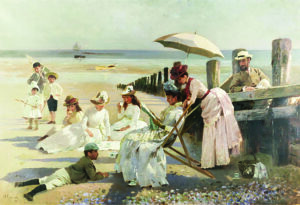(Editor’s note: DeeDee Wood is the owner of Black Cat Curiosities, an online antiques research and sales venue.)
The Victorians and people from even earlier eras were often told by their doctors to go “soak in the sea,” a medical advisement to go get some sea and salt air to cure what ailed you.
Antiques were involved, of course, which include umbrellas, sand pails, your bathing suit, literature to read, hats, games to play and more. The scene was a very different one from today’s beachgoers, and defined an era of early tourism that went hand-in-hand with medical practices for the ill. 
The Romans and Italians had “seaside resorts,” a place of respite for weary travelers or residents of those countries to have a leisure day of sand and surf in the waves of the ocean. As time progressed, especially in 17th and 18th century Europe, and more narrowly focusing on England, doctors suggested a dip in the ocean to cure what ailed you. It was thought the sea air and calming gentleness of the waves could cure anything from tuberculosis, anxiety, skin conditions and more.
One antique from this era to discuss would be the contraption known as the bathing house. A small carriage with four sides, a roof, and steps, it provided a private place for seagoers to don their modest bathing suits and soak in the ocean’s “nutrient-filled medicine.” As a litmus for this time period, modesty was paramount and revealing clothing or showing too much skin was taboo, thus the bath house provided some accommodation. A small flag fit into the roof in some cases and let the attendant know that the bather was ready to be rolled back into shore. Like many of these ocean-going activities, most were for the affluent who could afford these early tourism-type resorts.
One of the most sought-after antiques from Victorian or early beach-going would be that of the sand pail. Usually made of metal or lithographed images, the innocuous sand pail has become a darling of ocean or beach antique collectors. Brightly painted images of children at play, waves of the ocean, letter graphics describing sea time fun and other colorful images adorned these pails and were manufactured by companies like U.S. Metal Toy Manufacturing Company, Ohio Art Company and others from around the world. They are collected today as a bit of nostalgia from the beach.
Antique bathing suits from this era are also a collector’s item. Modesty was king during the time period from early prescription medical advisement on beachgoing in the 1700s, all the way into the 1950s. A span of time and fashion finds a vintage clothing collector having choices of early beachwear, including heavy layers, collars, hats and even footwear (basically street clothes in the water,) all the way up to 1950s beachwear the still involved covering the body from collarbone to mid-thigh. Men had it easier in this department, but early men’s bathing costumes did cover the entire body, and did not leave room for exposing too much skin.
Ettiquite, costumes and materials available, as well as social norms on what was appropriate ruled beachgoing all the way into the 20th century. Many people collect these antique bathing suits for nostalgia and interest.
Other antique items to consider in the days gone by of beach visitation and early tourism would be magazine ads for early resorts, games played on the beach, such as croquette or ball games, paintings of the sea painted by travelers or artists interested in beaches and ocean themes as the traveling became popular, and other accoutrements, such as umbrellas, hand fans, hats and footwear.
Whether people of antiquity used the beach for medical advisement, artistic inspiration, or early tourism, one thing is clear-peopled loved and still love going to the beach. Next time you venture down to the ocean with your family or friends, consider the myriad of reasons people have come before you, and the antiques involved in the beach experience.
Clothing choices, bathing houses, toys in the sand and literature to consider all have transposed into our modern era, but have echoes of beachgoing of the past, all with one general theme-people love the sea and sand in the summertime.



